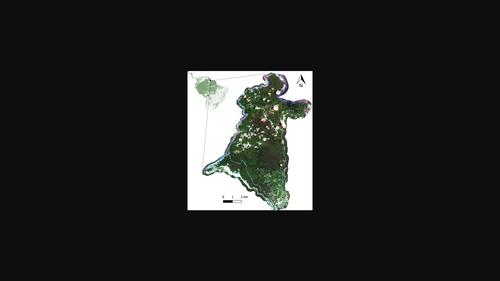当前位置:
X-MOL 学术
›
Remote Sens. Ecol. Conserv.
›
论文详情
Our official English website, www.x-mol.net, welcomes your
feedback! (Note: you will need to create a separate account there.)
Detecting gold mining impacts on insect biodiversity in a tropical mining frontier with SmallSat imagery
Remote Sensing in Ecology and Conservation ( IF 3.9 ) Pub Date : 2022-01-21 , DOI: 10.1002/rse2.250 Eric Stoll 1 , Anand Roopsind 2, 3 , Gyanpriya Maharaj 1 , Sandra Velazco 3 , T Trevor Caughlin 3
Remote Sensing in Ecology and Conservation ( IF 3.9 ) Pub Date : 2022-01-21 , DOI: 10.1002/rse2.250 Eric Stoll 1 , Anand Roopsind 2, 3 , Gyanpriya Maharaj 1 , Sandra Velazco 3 , T Trevor Caughlin 3
Affiliation

|
Gold mining is a major driver of Amazonian forest loss and degradation. As mining activity encroaches on primary forest in remote and inaccessible areas, satellite imagery provides crucial data for monitoring mining-related deforestation. High-resolution imagery, in particular, has shown promise for detecting artisanal gold mining at the forest frontier. An important next step will be to establish relationships between satellite-derived land cover change and biodiversity impacts of gold mining. In this study, we set out to detect artisanal gold mining using high-resolution imagery and relate mining land cover to insects, a taxonomic group that accounts for the majority of faunal biodiversity in tropical forests. We applied an object-based image analysis (OBIA) to classify mined areas in an Indigenous territory in Guyana, using PlanetScope imagery with ~3.7 m resolution. We complemented our OBIA with field surveys of insect family presence or absence in field plots (n = 105) that captured a wide range of mining disturbances. Our OBIA was able to identify mined objects with high accuracy (>90% balanced accuracy). Field plots with a higher proportion of OBIA-derived mine cover had significantly lower insect family richness. The effects of mine cover on individual insect taxa were highly variable. Insect groups that respond strongly to mining disturbance could potentially serve as bioindicators for monitoring ecosystem health during and after gold mining. With the advent of global partnerships that provide universal access to PlanetScope imagery for tropical forest monitoring, our approach represents a low-cost and rapid way to assess the biodiversity impacts of gold mining in remote landscapes.
中文翻译:

使用 SmallSat 图像检测金矿开采对热带采矿边界昆虫生物多样性的影响
金矿开采是亚马逊森林损失和退化的主要驱动力。随着采矿活动侵占偏远和人迹罕至地区的原始森林,卫星图像为监测与采矿相关的森林砍伐提供了重要数据。尤其是高分辨率图像,已显示出在森林边界探测手工金矿开采的前景。重要的下一步将是建立卫星衍生的土地覆盖变化与金矿开采对生物多样性影响之间的关系。在这项研究中,我们着手使用高分辨率图像检测手工金矿开采,并将采矿土地覆盖与昆虫联系起来,昆虫是一种占热带森林动物生物多样性大部分的分类群。我们应用基于对象的图像分析 (OBIA) 对圭亚那土著领土的雷区进行分类,使用分辨率约为 3.7 m 的 PlanetScope 图像。我们通过实地调查(n = 105)中的昆虫家族存在或不存在来补充我们的 OBIA,这些调查捕捉到了广泛的采矿干扰。我们的 OBIA 能够以高精度(>90% 的平衡精度)识别开采的物体。具有较高比例的 OBIA 衍生矿覆盖的田间地块的昆虫科丰富度显着降低。地雷覆盖对单个昆虫类群的影响是高度可变的。对采矿干扰反应强烈的昆虫群可能成为监测金矿开采期间和之后生态系统健康状况的生物指标。随着全球合作伙伴关系的出现,为热带森林监测提供对 PlanetScope 图像的普遍访问,
更新日期:2022-01-21
中文翻译:

使用 SmallSat 图像检测金矿开采对热带采矿边界昆虫生物多样性的影响
金矿开采是亚马逊森林损失和退化的主要驱动力。随着采矿活动侵占偏远和人迹罕至地区的原始森林,卫星图像为监测与采矿相关的森林砍伐提供了重要数据。尤其是高分辨率图像,已显示出在森林边界探测手工金矿开采的前景。重要的下一步将是建立卫星衍生的土地覆盖变化与金矿开采对生物多样性影响之间的关系。在这项研究中,我们着手使用高分辨率图像检测手工金矿开采,并将采矿土地覆盖与昆虫联系起来,昆虫是一种占热带森林动物生物多样性大部分的分类群。我们应用基于对象的图像分析 (OBIA) 对圭亚那土著领土的雷区进行分类,使用分辨率约为 3.7 m 的 PlanetScope 图像。我们通过实地调查(n = 105)中的昆虫家族存在或不存在来补充我们的 OBIA,这些调查捕捉到了广泛的采矿干扰。我们的 OBIA 能够以高精度(>90% 的平衡精度)识别开采的物体。具有较高比例的 OBIA 衍生矿覆盖的田间地块的昆虫科丰富度显着降低。地雷覆盖对单个昆虫类群的影响是高度可变的。对采矿干扰反应强烈的昆虫群可能成为监测金矿开采期间和之后生态系统健康状况的生物指标。随着全球合作伙伴关系的出现,为热带森林监测提供对 PlanetScope 图像的普遍访问,











































 京公网安备 11010802027423号
京公网安备 11010802027423号